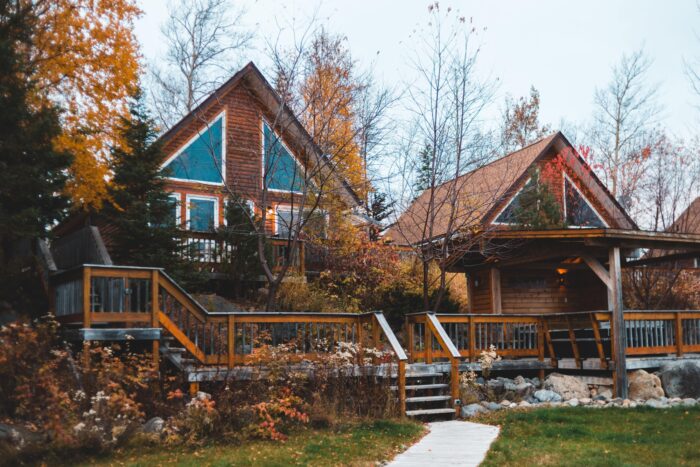HOW LONG DOES VINYL SIDING LAST?
By understanding what impacts your siding’s lifespan, you can maintain its quality and recognize when it’s time for a replacement.
READ MORE
Many homeowners love the aesthetic of hardwood in their interior and exterior designs — they’re luxurious, fun to look at, uniquely patterned and super chic. Among the popular hardwood choices available on the market, cedar is one of the best.
Cedar is high-end and durable, especially because it isn’t prone to warping like other wood types when exposed to high heat or water. Of course, when used on a home’s exterior, they present some issues that make them a less attractive option.
Here’s everything you need to know about real cedar soffit and fascia and some alternatives that may be worth your attention.
To answer this question, we have to define a few different things. First, cedar is a hardwood used for home development and improvement projects. It’s often used in decking, siding, fencing and trim because it is highly durable and doesn’t warp like other, more expensive wood types.
Second, soffit and fascia are architectural elements featured in roofing systems. Soffit covers the underside of a roof’s eave, to protect the structural integrity of the home’s roof, walls, attic and foundation. Fascia is the board installed along the eave’s edge, usually connected to or touching the soffit panels.
So, real cedar soffit and fascia are essentially cedar panels and fascia boards that have been created from cedar wood. They are popular among homeowners who want to use hardwood for their home’s exterior design.

Cedar is preferable to many other hardwood options, but there are a few problems that you might run into if you decide to use it on your home’s exterior. Here are five disadvantages of using real cedar soffit and fascia on your home:
Cedar bleed is a natural occurrence with cedar wood. It happens when the natural tannins within the wood are pulled to the surface, and the color bleeds through the paint or stains the wood’s unpainted surface. It can make your soffit and fascia look like they have large, reddish-brown stains, ultimately affecting your home’s overall curb appeal.
Cedar also doesn’t hold paint particularly well. If you want to use cedar wood but want to paint the panels to match your home’s exterior design, you might be in trouble. Unfortunately, painted cedar is also prone to chipping, flaking and peeling when exposed to the elements, which is why it’s best to leave cedar wood unpainted.
Cedar wood doesn’t warp like other hardwoods when exposed to the harsh outdoors, but it does something potentially much worse — it cracks! This process is called “checking” and results in large cracks or openings in the wood, making it highly vulnerable to water damage and insect infestations. A cracked soffit or fascia board can’t properly do its job.
Due to these problems, you will be forced to replace panels and boards and provide ongoing maintenance for cedar soffit and fascia. There are so many boards in a soffit installation that it can mean lots of work and excessive spending. If you use cedar soffit and fascia, you will most likely spend a lot of time and money to maintain its look.
The last and final disadvantage of cedar soffit and fascia is the lack of ventilation. With other materials, tiny holes are added to the soffit panels to provide extra air circulation for the attic, which ultimately helps reduce overall energy consumption. That’s much more difficult to accomplish with cedar, so many cedar soffit options don’t come with it.
Real cedar is not a preferable option for soffit and fascia. Fortunately, other material options on the market work exceptionally well.
Here are three durable, cost-effective and aesthetically pleasing alternatives to real cedar soffit and fascia.
Vinyl is incredibly popular in the home improvement and development industry, and that’s because it’s one of the most durable and cost-effective material options on the market. It’s a versatile material that can be utilized for numerous exterior applications, including siding, soffit, fascia and more.
Fiber cement is another material alternative that far surpasses real cedar in almost every way. Made from cellulose fiber, cement, silica and sand, fiber cement is one of the most durable materials on the market. The potential downsides are that they’re more expensive than other alternatives and require expertise to install. In addition, fiber cement is an incredibly heavy material to ship, so if you’re looking for a cost-effective option, this may not be the best choice.
Aluminum soffit and fascia are probably the most popular options among contractors and developers — and for good reason! This material is incredibly strong, providing maximum protection for your roof, walls and foundation. Plus, it’s more affordable than many high-cost options, providing the highest level of durability at a fraction of the cost. In addition, aluminum soffit and fascia come in lots of different colors and complement all types of homes..
If you’re on the hunt for top-of-the-line soffit and fascia products from a company with experience, look no further! At Rollex, we specialize in creating exterior aluminum, steel and vinyl products that are built to withstand the harshest conditions and elevate curb appeal in the process. Contact us today to learn more!